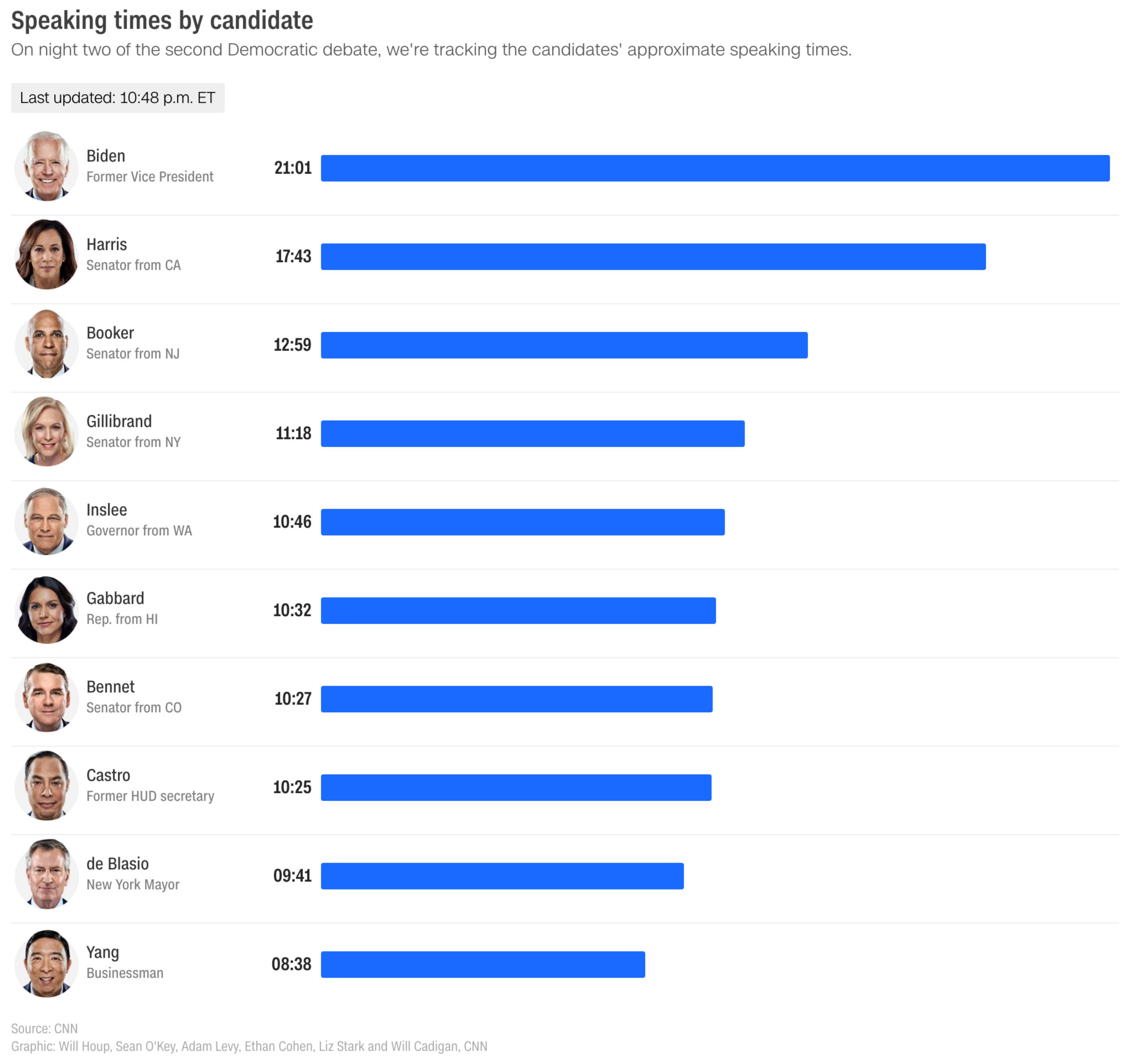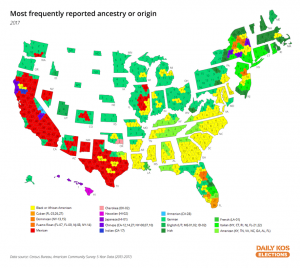Perry Bacon, Jr. addresses the question, “Is Trump’s Use Of Identity Politics An Effective Strategy?” at FiveThirty Eight, and observes: “Does the way Trump use white identity politics help him and the GOP electorally, even if he at times veers into racism that members of his own party can’t defend? And are the Democrats (usually more establishment, centrist figures) who worry the party is playing into Trump’s hands when it defends members of Congress like Rep. Ilhan Omar of Minnesota generally right, at least in terms of political strategy?” Bacon concludes, that yes it probably did help him win the GOP 2016 primaries. However, “the way Trump talked about race and identity helped him win the general election is less clear…there are reasons to be skeptical that his rhetoric on race and identity was the main explanation for Trump’s victory…Americans may have decided to support Trump for reasons other than his stances on identity issues (for example, perhaps because he was an outsider to politics). According to Enns, these Trump voters may have then adjusted their views on immigration and other issues to align with Trump’s, as opposed to backing Trump because of his stance on racial and identity issues…”
Bacon adds that “some election models that ignored the two candidates and instead focused on factors like the economy and Obama’s approval rating predicted that Republicans would win. Whatever the merits of Trump (and Clinton’s strategies), the overwhelming majority of 2016 voters backed the same party as they did in 2012. By far the most important factor in Trump’s victory in 2016 was that he was the GOP nominee for president and millions of Republican-leaning voters likely backed him simply because they are Republicans…A perfectly plausible theory of the 2016 election would go something like this: Trump’s racial rhetoric turned off some voters, brought in some new ones, and was basically an electoral wash…To conclude, I think the safest answer to the question of whether Trump’s identity politics are a good strategy, at least in a general election, is “we don’t really know” or “maybe, maybe not.” He won in 2016, but his party lost in 2018 — and both of those elections had a lot more at play than just how Trump spoke about issues of race and identity.”
Looking toward 2020, Bacon concludes “That debate over policy and messaging to some extent overlaps with the 2020 Democratic primary contest. Does the party choose a candidate who might appeal to Obama-Trump voters with his or her populist economic stances (Sanders, Elizabeth Warren) or maybe a candidate who might appeal to those same voters by virtue of being a white man or downplaying his liberalism on these issues of race and identity (Joe Biden?). Or does the party pick a person who might focus on mobilizing college-educated white voters and minorities and takes more liberal stances on issues of race and identity (Beto O’Rourke)? And should the party be worried candidates who are not white and male (Cory Booker, Kamala Harris, Warren) will be seen as embodying the diversity of the country in a way that some Trump voters don’t like?”
However, New York Times columnist Thomas B. Edsall reports “Daniel Hopkins, a political scientist at Penn, wrote me that in 2016 voters incorrectly identified Trump’s political agenda. “Many people underestimated the extent to which Donald Trump was perceived as ideologically moderate by 2016 general election voters,” Hopkins wrote…In October of that year, just before the election, 17 percent of respondents in an Institute for the Study of Citizens and Politicspanel survey described Trump as “extremely conservative” and 31 percent described him as “conservative,” for a total of 48 percent. In contrast, in 2012, 22 percent said that Mitt Romney was extremely conservative and 45 percent said conservative, for a total of 67 percent…This leads to an unanswered question: Are all of Trump’s adherents unshakably loyal or can some of them be persuaded to flip, motivated by the reality described on Monday by my colleagues Jonathan Martin and Maggie Haberman: that while Trump claims to be a pro-worker populist, he has governed as a trickle-down Republican elitist…In some respects, Trump was flying under a false flag in 2016. Will he pay a price in 2020 when he has to fly under his true colors?”
Also at FiveThirtyEight, Nate Silver makes the case that “Medicare For All Isn’t That Popular — Even Among Democrats.” Silver explains, “Whether you love, hate or are indifferent toward his “Medicare for All” plan, polls show Sanders leading when Democratic voters are asked which candidate they think is best able handle to health care…The thing is, though — according to new polling from Marist College this week — Sanders’s plan isn’t actually the most popular idea in the field. Instead, that distinction belongs to what Marist calls “Medicare for all that want it,” or what’s sometimes called a public option — something very similar to Joe Biden’s recently unveiled health care plan, which claims to give almost everyone “the choice to purchase a public health insurance option like Medicare.”…In the Marist poll, 90 percent of Democrats thought a plan that provided for a public option was a good idea, as compared to 64 percent who supported a Sanders-style Medicare for All plan that would replace private health insurance. The popularity of the public option also carries over to independent voters: 70 percent support it, as compared to 39 percent for Medicare for All.”
But Silver cautions, “there’s more to winning elections than just picking whatever policies happen to poll best; Medicare for All is consistent with the sort of revolutionary change for which Sanders advocates…At the same time, the public option is potentially a winning issue for Biden, and one that allows him to reinforce some of his core strengths. It offers greater continuity with the legacy of the Obama administration (since the public option is a more gradual change from Obamacare — not to mention, something Obamacare initially tried to include), and allows him to double down on his electability message, since it polls better than eliminating private insurance. That may be why Biden has gone on the offense against Medicare for All.” Silver concludes that Harris and Warren, who have endorsed the Sanders Medicare for all approach, may well introduce their own modifications in the months ahead. What we may have here is Sanders playing the bad cop, Biden the good cop, and Warren or Harris providing the compromise that can unify the party and win over persuadable voters.
At The Atlantic, Ronald Browstein probes the political views of a largely unexplored demographic “Will Trump’s Racist Attacks Help Him? Ask Blue-Collar White Women. His strategy rests on a bet: that these voters will respond just as enthusiastically to his belligerence as working-class white men.” Brownstein writes, “The white working-class men look like they are approaching the 2016 margins for Trump, but not the women,” says the veteran Democratic pollster Stanley Greenberg, in a judgment supported by public polling. “Clearly the women are in a different place.” Greenberg conducted the focus groups, whose findings were released today, for the American Federation of Teachers…If you think about the strategy they had in ’16 … where he campaigned and went into these [blue-collar and nonmetropolitan] areas and really drove up the vote—that doesn’t work if the women aren’t responding to it, if they watch him and they get put off by it,” Greenberg says. “It only works if women are part of the story. You just can’t get the numbers if half of white working-class, nonmetro voters are put off by what you are doing.”” Brownstein adds, “But Trump’s strategy faces a huge obstacle if working-class women don’t buy in to his message as much as working-class men. That’s for a simple reason: Every data source—from the exit polls to the Pew Research Center’s analysis of voter files to studies by Catalist, a Democratic voter-targeting firm—shows that these women reliably cast slightly more than half of all the votes from the white working class…”
Brownstein notes further, that “in 2018, Republicans sagged among these women. Nationally, GOP House candidates still won their vote overall, but by less robust margins than Trump did two years before: 14 points per the exit polls and 17 percent per the Catalist calculations. And Democrats in 2018 generally performed much better with these voters in marquee Senate and governor’s contests in Pennsylvania, Michigan, and Wisconsin. (Only in the Senate race in Michigan and in the governor’s race in Wisconsin did Republicans retain a solid lead with these voters.)..Trump’s job-approval rating on Election Day 2018 among these women stood at just more than 50 percent in all three states, according to detailed results provided to me by Edison Research, which conducts exit polls for a consortium of media organizations. In each state, that represented a decline of about five percentage points from his share of their vote in the presidential election. That’s not a radical shift, but in three states that were decided by a combined 78,000 votes in 2016, it could have a powerful impact…National polls since the 2018 election have continued to show Trump facing a cooling reception from these women. Both the latest NBC/Wall Street Journalpoll, released early last week, and the NPR/PBS NewsHour/Marist poll released this week show him with a net-positive approval rating of just seven percentage points among blue-collar women, well below his vote advantage in 2016. The Marist poll found them divided almost exactly evenly on whether they intend to vote for or against Trump for reelection. That’s a much more tenuous equation than Trump faces among blue-collar white men. Both of the latest national surveys from NBC/Wall Street Journal and Marist found that the share of those men who approve of his performance still stands about 30 percentage points higher than the number who disapprove.”
However, Brownstein warns, “This week’s NPR/PBS NewsHour/Marist poll suggests that non-college-educated white women are essentially just as hostile as working-class white men to vanguard liberal ideas that have emerged in the 2020 Democratic presidential race. Those issues include a single-payer health-care plan that would eliminate private insurance, allowing undocumented immigrants access to any federally funded health-care plan, and decriminalizing unauthorized crossing of the U.S. border. Additionally, while recent polls by the nonpartisan Public Religion Research Institute show that these women don’t quite match the hostility of the men in their cohort to a wide array of demographic and social changes in the country, a majority agree on several ideas: that the growing number of immigrants threatens traditional American values, that the U.S. way of life must be protected against foreign influence, and that white people face as much discrimination as black people. All of those attitudes correlate with support for Trump.”










